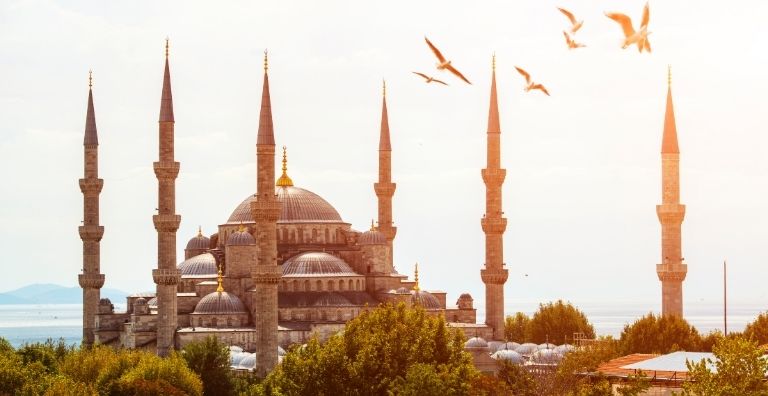
TURKIYE
To understand and describe Türkiye, we believe that it is essential to firstly understand the Turks, then the geography of Türkiye, and finally the history of the Anatolian and Thracian regions.
The area where Turks emerged on the historical scene is known as Central Asia, bordered by Siberia to the north, the Sea of Japan and Korea to the east, China to the south, and the Aral Sea to the west. Much of this region lies within the current borders of Mongolia. Although there are sources that refer to much earlier periods, the 3rd century BC is generally accepted as the time when Turkic tribes began to appear in history. The first tribe to unite the Turks under a political organization was the Huns. This empire became a significant power in Central Asia and maintained its dominance between 220 BC and 216 AD. Following this period, various Turkic states were established, including the European Hun Empire (374-469), the Hephthalite Empire (420-562), the Göktürk Empire (552-745), the European Avar Empire (565-803), the Khazar Empire (468-965), the Uighur Empire (745-940), the Karakhanid State (840-1040), and the Ghaznavid State (962-1187), with Turkic tribes continuing to unite under political entities.
Starting from the 11th century, the westward expansion of Turkic states, especially towards Anatolia, accelerated. During the reigns of the Great Seljuk Empire (1040-1157) and the Anatolian Seljuk State (1077-1187), Anatolia became a homeland for the Turks. The Ottoman State, founded in 1299 and lasting until 1922, became a world empire during the 16th and 17th centuries. From the 18th century, the Ottoman Empire began to decline politically, economically, and militarily, eventually losing all its territories outside Anatolia after World War I.
With the National Campaign initiated by Mustafa Kemal Atatürk and his comrades on May 19, 1919, the Turkish nation, which was largely occupied and intended to be subjugated, emerged victorious. Through the Mudanya Armistice Agreement (October 11, 1922) and the Lausanne Peace Treaty (July 24, 1923), the Turkish nation reaffirmed its independence to the world. Consequently, with the proclamation of the Republic on October 29, 1923, the newly reborn Republic of Turkey re-entered the civilized world stage where it will remain forever.
Geographically, Turkey is positioned between Europe, Asia, and the Middle East, acting as a natural bridge between these regions. It spans approximately 1,600 kilometers from east to west and about 800 kilometers from north to south, covering an area of 783,562 square kilometers. While a small part of Türkiye, known as Thrace, lies in the southeastern part of the European continent, the larger portion is situated in Western Asia. Türkiye is bordered by the Black Sea to the north, Georgia and Armenia to the northeast, Azerbaijan and Iran to the east, Iraq and Syria to the southeast, the Mediterranean Sea and the Aegean Sea to the southwest and west, and Greece and Bulgaria to the northwest. One of Türkiye ‘s most notable geographical features is the straits separating the Black Sea from the Aegean Sea: the Bosphorus and the Dardanelles.
Beyond its geographical and strategic importance, today’s Türkiye has become a cultural basin, hosting various civilizations and cultures throughout history. Göbeklitepe (9600-9500 BC), symbolizing the transition from the Paleolithic to the Neolithic Age; Çatalhöyük (7400-5700 BC), considered the first urban settlement of the Neolithic Age; Kaniş-Karum and the Assyrian Trade Colonies (2000-1750 BC) show the deep history and culture of Anatolia. This cultural basin was later enriched by the Hittites (1800-1178 BC), the greatest and most powerful political entity in Anatolia, followed by the Phrygians (1200-700 BC), Lydians (1216-541 BC), Urartians (900-600 BC), Persians (585-332 BC), Alexander the Great (332-130 BC), Romans (17 BC-395 AD), and the Byzantine Empire (395-1453 AD), before coming under Turkish dominance from the 11th century onwards.
Today, Türkiye is administratively divided into seven geographical regions and 81 provinces. These regions are the Marmara region, the Aegean region, the Mediterranean region, the Southeastern Anatolia region, the Central Anatolia region, the Black Sea region, and the Eastern Anatolia region. In 2024, Türkiye ‘s population is 85,372,377, making it the 18th most populous country in the world. The most populous province is Istanbul, with 15,655,924 people, followed by Ankara with 5,803,482 people, and İzmir with 4,479,525 people.
Bibliography
– Bayrak, M. O. (2002). Türk İmparatorlukları Tarihi. İstanbul: Bilge Karınca Yayınları.
– Kaya, M. A. (2021). Türkiye’nin Eski Çağ Tarihi 1. İstanbul: Bilge Kültür Sanat.
– Lloyd, S. (2002). Türkiye’nin Tarihi. Ankara: Tübitak.
